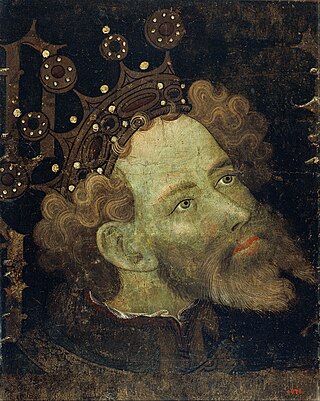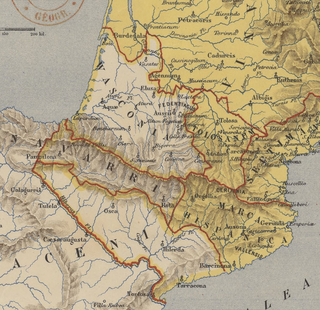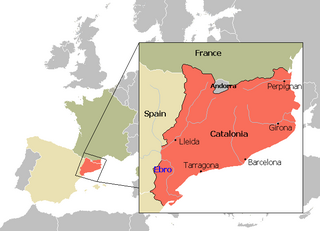Related Research Articles

The recorded history of the lands of what today is known as Catalonia begins with the development of the Iberian peoples while several Greek colonies were established on the coast before the Roman conquest. It was the first area of Hispania conquered by the Romans. It then came under Visigothic rule after the collapse of the western part of the Roman Empire. In 718, the area was occupied by the Umayyad Caliphate and became a part of Muslim ruled al-Andalus. The Frankish Empire conquered northern half of the area from the Muslims, ending with the conquest of Barcelona in 801, as part of the creation of a larger buffer zone of Christian counties against Islamic rule historiographically known as the Marca Hispanica. In the 10th century the County of Barcelona became progressively independent from Frankish rule.

Alfonso II, called the Chaste or the Troubadour, was the King of Aragon and, as Alfons I, the Count of Barcelona from 1164 until his death. The eldest son of Count Ramon Berenguer IV of Barcelona and Queen Petronilla of Aragon, he was the first King of Aragon who was also Count of Barcelona. He was also Count of Provence, which he secured from Douce II and her would-be father-in-law Raymond V, Count of Toulouse, from 1166 until 1173, when he ceded it to his brother, Ramon Berenguer III. His reign has been characterised by nationalistic and nostalgic Catalan historians as l'engrandiment occitànic or "the Pyrenean unity": a great scheme to unite various lands on both sides of the Pyrenees under the rule of the House of Barcelona.

Peter IV, called the Ceremonious, was from 1336 until his death the king of Aragon, Sardinia-Corsica, and Valencia, and count of Barcelona. In 1344, he deposed James III of Majorca and made himself King of Majorca.
John I, called by posterity the Hunter or the Lover of Elegance, or the Abandoned in his lifetime, was the King of Aragon from 1387 until his death.

Petronilla, whose name is also spelled Petronila or Petronella, was Queen of Aragon (1137–1164) from the abdication of her father, Ramiro II, in 1137 until her own abdication in 1164. After her abdication she acted as regent during the minority of her son Alfonso II of Aragon (1164–1173). She was the last ruling member of the Jiménez dynasty in Aragon, and by marriage brought the throne to the House of Barcelona.

The Spanish March or Hispanic March was a military buffer zone established c.795 by Charlemagne in the eastern Pyrenees and nearby areas, to protect the new territories of the Christian Carolingian Empire—the Duchy of Gascony, the Duchy of Aquitaine, and Septimania—from the Muslim Umayyad Emirate of Córdoba in al-Andalus.

The Crown of Aragon was a composite monarchy ruled by one king, originated by the dynastic union of the Kingdom of Aragon and the County of Barcelona and ended as a consequence of the War of the Spanish Succession. At the height of its power in the 14th and 15th centuries, the Crown of Aragon was a thalassocracy controlling a large portion of present-day eastern Spain, parts of what is now southern France, and a Mediterranean empire which included the Balearic Islands, Sicily, Corsica, Sardinia, Malta, Southern Italy, and parts of Greece.
Robert d'Aguiló, also known as Robert Bordet, was a Norman knight who moved from Normandy to Catalonia in the early 12th century. He was a native of Cullei, as reported by Orderic Vitalis, and his name d'Aguiló is a catalanized form of "d'Aculley" or "de Culley" that he adopted after marrying the daughter of a Catalan noble.

The Principality of Catalonia was a medieval and early modern state in the northeastern Iberian Peninsula. During most of its history it was in dynastic union with the Kingdom of Aragon, constituting together the Crown of Aragon. Between the 13th and the 18th centuries, it was bordered by the Kingdom of Aragon to the west, the Kingdom of Valencia to the south, the Kingdom of France and the feudal lordship of Andorra to the north and by the Mediterranean Sea to the east. The term Principality of Catalonia was official until the 1830s, when the Spanish government implemented the centralized provincial division, but remained in popular and informal contexts. Today, the term Principat (Principality) is used primarily to refer to the autonomous community of Catalonia in Spain, as distinct from the other Catalan Countries, and usually including the historical region of Roussillon in Southern France.

The County of Barcelona was a polity in northeastern Iberian Peninsula, originally located in the southern frontier region of the Carolingian Empire. In the 10th century, the Counts of Barcelona progressively achieved independence from Frankish rule, becoming hereditary rulers in constant warfare with the Islamic Caliphate of Córdoba and its successor states. The counts, through marriage, alliances and treaties, acquired or vassalized the other Catalan counties and extended their influence over Occitania. In 1164, the County of Barcelona entered a personal union with the Kingdom of Aragon. Thenceforward, the history of the county is subsumed within that of the Crown of Aragon, but the city of Barcelona remained preeminent within it.

Sancho, also spelled Sanç or Sanche, was a Catalano-Aragonese nobleman and statesman, the youngest son of Queen Petronilla of Aragon and Count Raymond Berengar IV of Barcelona. He was at different times the count of Cerdanya (c.1175–1188), Provence (1181–1185), Gévaudan, Rodez and Carlat (1183–1185), and Roussillon (1208–1212). He served as the regent of Provence from 1209 until 1218 during the minority of Count Raymond Berengar IV, and as regent of Aragon from 1214 until 1218, during the minority of King James I.
Douce I was the daughter of Gilbert I of Gévaudan and Gerberga of Provence and wife of Ramon Berenguer III, Count of Barcelona. In 1112, she inherited the county of Provence through her mother. She married Ramon Berenguer at Arles on 3 February that year.
William VI or Guillem VI was the eldest son of William V and his wife Ermessende, daughter of Count Peter I of Melgueil. William succeeded his father in the lordship of Montpellier in 1121, while still a minor, under his mother's guardianship. He suppressed a revolt of the bourgeoisie in 1143 and participated in several military campaigns of the Reconquista in Spain. He also increased the public character of the lordship in Montpellier and supported the growth of its trade.
Giraud II of Montreuil-Berlay was a twelfth-century feudal lord of Montreuil-Bellay, near Saumur in France. He was dispossessed of the Château de Montreuil-Bellay by Geoffrey Plantagenet.
The County of Pallars or Pallás was a de facto independent petty state, nominally within the Carolingian Empire and then West Francia during the ninth and tenth centuries, perhaps one of the Catalan counties, originally part of the Marca Hispanica in the ninth century. It was coterminous with the upper Noguera Pallaresa valley from the crest of the Pyrenees to the village of Tremp, comprising the Vall d'Àneu, Vall de Cardós, Vall Ferrera, the right bank of the Noguera Ribagorçana, and the valley of the Flamicell. It roughly corresponded with the historic region of Catalonia called Pallars. Its chief city was Sort.

The County of Pallars Jussà or Lower Pallars was a county in the Hispanic March during the eleventh and twelfth centuries, long after the march had ceased to be effectively administered by the Kings of France. It was a division of the County of Pallars, which had been de facto, and possible de jure, independent since the late ninth century. It roughly corresponded with the modern Catalan comarca of Pallars Jussà.
Mir Geribert was a Catalan nobleman and a rebel against the Count of Barcelona for almost two decades (1040–1059) as the self-declared "Prince of Olèrdola". His revolt was merely the longest and most severe of what was then endemic to Catalonia: private feudal warfare, which was theoretically restricted by the Peace and Truce of God, and disavowal of comital prerogatives by the castellans who nominally owed their positions to the count.

Olegarius Bonestruga was the Bishop of Barcelona from 1116 and Archbishop of Tarragona from 1118 until his death. He was an intimate of Ramon Berenguer III, Count of Barcelona, and often accompanied the count on military ventures.

The Liber feudorum maior, originally called the Liber domini regis, is a late twelfth-century illuminated cartulary of the Crown of Aragon. It was compiled by the royal archivist Ramon de Caldes with the help of Guillem de Bassa for Alfonso II, beginning in 1192. It contained 902 documents dating as far back as the tenth century. It is profusely illustrated in a Romanesque style, a rarity for utilitarian documents. The LFM is an indispensable source for the institutional history of the emerging Principality of Catalonia. It is preserved as a file in the Arxiu de la Corona d'Aragó (ACA), Cancelleria reial, Registres no. 1, in Barcelona.

The Catalan Courts or General Court of Catalonia were the policymaking and parliamentary body of the Principality of Catalonia from the 13th to the 18th century.
References
- ↑ "Library of Congress LCCN Permalink n81147078". lccn.loc.gov. Retrieved 2024-08-30.
- 1 2 "Thomas N. Bisson". history.fas.harvard.edu.
- 1 2 "Fellows - The Medieval Academy of America". www.medievalacademy.org.
- 1 2 "APS Member History". search.amphilsoc.org.
- 1 2 "Thomas Noel Bisson | American Academy of Arts and Sciences". www.amacad.org. April 2, 2024.
- ↑ "Reial Acadèmia de Bones Lletres". www.boneslletres.cat.
- 1 2 "Professor Thomas Bisson FBA". The British Academy.
- ↑ "Bisson, Thomas Noel, 1958 - Finding Aids". findingaids.princeton.edu.
- ↑ "Standing Committees for 2000-01 - Faculty of Arts and Sciences". Harvard Gazette. February 8, 2001.
- ↑ "Thomas N. Bisson". medieval.fas.harvard.edu.
- ↑ Bartlett, Robert (June 24, 2010). "Lords of 'Pride and Plunder'" – via www.nybooks.com.
- ↑ Bisson, Thomas N. (November 11, 2010). "Knights, Castles, and Power" – via www.nybooks.com.
- ↑ Handhe, Margaretta S. (January 3, 1999). "Tormented Voices: Power, Crisis, and Humanity in Rural Catalonia, 1140–1200: Bisson, Thomas N.: Cambridge: Harvard University Press 224 pp., Publication Date: August 1998". History: Reviews of New Books. 27 (2): 78–79. doi:10.1080/03612759.1999.10528329 – via CrossRef.
- ↑ McGlynn, Sean (October 1, 2022). "Thomas N. Bisson, ed. and trans., The Chronography of Robert of Torigni . Vol. 1, The Chronicle, A.D. 1100–1186 . Vol. 2, Related Historical Texts . (Oxford Medieval Texts.) Oxford: Oxford University Press, 2020. Pp. cxii, 393; xl, 455; black-and-white figures. $230. ISBN: 978-0-1996-8212-6". Speculum. 97 (4): 1161–1162. doi:10.1086/721891 – via CrossRef.
- ↑ Bisson, T. N. (1994). "The "Feudal Revolution"". Past & Present (142): 6–42. doi:10.1093/past/142.1.6. JSTOR 651195 – via JSTOR.
- ↑ "Pouvoir et consuls à Toulouse (1150-1205) | WorldCat.org". search.worldcat.org.
- ↑ "Thomas N. Bisson". John Simon Guggenheim Memorial Foundation...
- ↑ "Haskins Medal Recipients - The Medieval Academy of America". www.medievalacademy.org.
- ↑ "Thomas N. Bisson - Honoris - Universitat Autònoma de Barcelona - UAB Barcelona". www.uab.cat.
- ↑ "Newsmakers". Harvard Gazette. January 24, 2002.